Can You Put Sunscreen In A Travel Bottle? It’s a common question for travelers looking to save space and comply with TSA regulations, but the answer is more complex than a simple yes or no. At TRAVELS.EDU.VN, we understand the importance of sun protection while traveling, and we’re here to provide you with the facts about decanting sunscreen and the potential risks involved. Explore alternative travel-friendly sunscreen options and ensure your skin stays protected on your next adventure with travel-sized sunscreens, SPF effectiveness, and sun care tips.
1. The Risks of Transferring Sunscreen to Travel Bottles
Decanting your favorite sunscreen into a smaller travel bottle seems like a practical solution for carry-on compliance, but it can compromise the sunscreen’s effectiveness. Cosmetic chemist Dr. Michelle Wong from Sydney, Australia, explains that the new container can cause the sunscreen to degrade. This degradation can significantly reduce its ability to protect your skin from harmful UV rays.
1.1. Potential Reactions with the Container Material
Many sunscreen ingredients act as solvents, meaning they can react with the plastic of the travel bottle. Dr. Wong notes that these ingredients may leach into the plastic or cause the plastic to break down. This reaction alters the sunscreen’s composition, potentially affecting how it spreads on your skin and ultimately reducing its protective capabilities.
1.2. Reduced Protection Against Sunlight and Air
The original packaging of your sunscreen is designed to protect the formula from air and light, both of which can degrade the active ingredients. Travel bottles may not offer the same level of protection. Exposure to light can break down the ingredients, while air can cause the emulsion to separate, leading to uneven application and decreased SPF effectiveness.
1.3. Risk of Contamination
Reusing old containers, even after cleaning, can introduce microbes that contaminate the sunscreen. These microbes can further degrade the sunscreen’s active ingredients, diminishing its efficacy. Ensuring a sterile environment for your sunscreen in a travel bottle is challenging, making contamination a significant concern.
2. Understanding Sunscreen Degradation
Sunscreen degradation is a process where the active ingredients in sunscreen break down, reducing their ability to absorb or reflect UV radiation. This degradation can occur due to various factors, including exposure to air, light, heat, and incompatible materials.
2.1. How Quickly Can Sunscreen Degrade?
The speed at which sunscreen degrades can vary depending on the specific formulation and environmental conditions. However, cosmetic scientist Ava Perkins tested some mineral sunscreens and found that they began to harden within just a few days of being transferred to a different container. This rapid change underscores the importance of keeping sunscreen in its original packaging.
2.2. Factors Affecting Sunscreen Stability
Several factors influence the stability and effectiveness of sunscreen:
- Storage Conditions: High temperatures and direct sunlight can accelerate the degradation process.
- Packaging Material: Incompatible plastics can react with sunscreen ingredients, causing them to break down.
- Exposure to Air: Oxidation can degrade certain active ingredients, reducing their efficacy.
- Contamination: Microbes can introduce enzymes that degrade the sunscreen’s protective components.
2.3. Visual Signs of Sunscreen Degradation
Keep an eye out for these visual signs that your sunscreen may have degraded:
- Change in Texture: The sunscreen may become lumpy, grainy, or separated.
- Change in Color: The color may darken or become discolored.
- Change in Smell: An unusual or off-putting odor may indicate degradation.
- Difficulty in Application: The sunscreen may not spread evenly or may feel different on the skin.
3. Travel-Friendly Sunscreen Options
Instead of risking the degradation of your favorite sunscreen, consider these travel-friendly alternatives that comply with TSA regulations and maintain the product’s integrity.
3.1. Sunscreen Sticks
Sunscreen sticks are solid formulas measured in ounces rather than fluid ounces, so they don’t count towards your liquid quota. They are convenient, mess-free, and easy to apply, making them an excellent choice for travel.
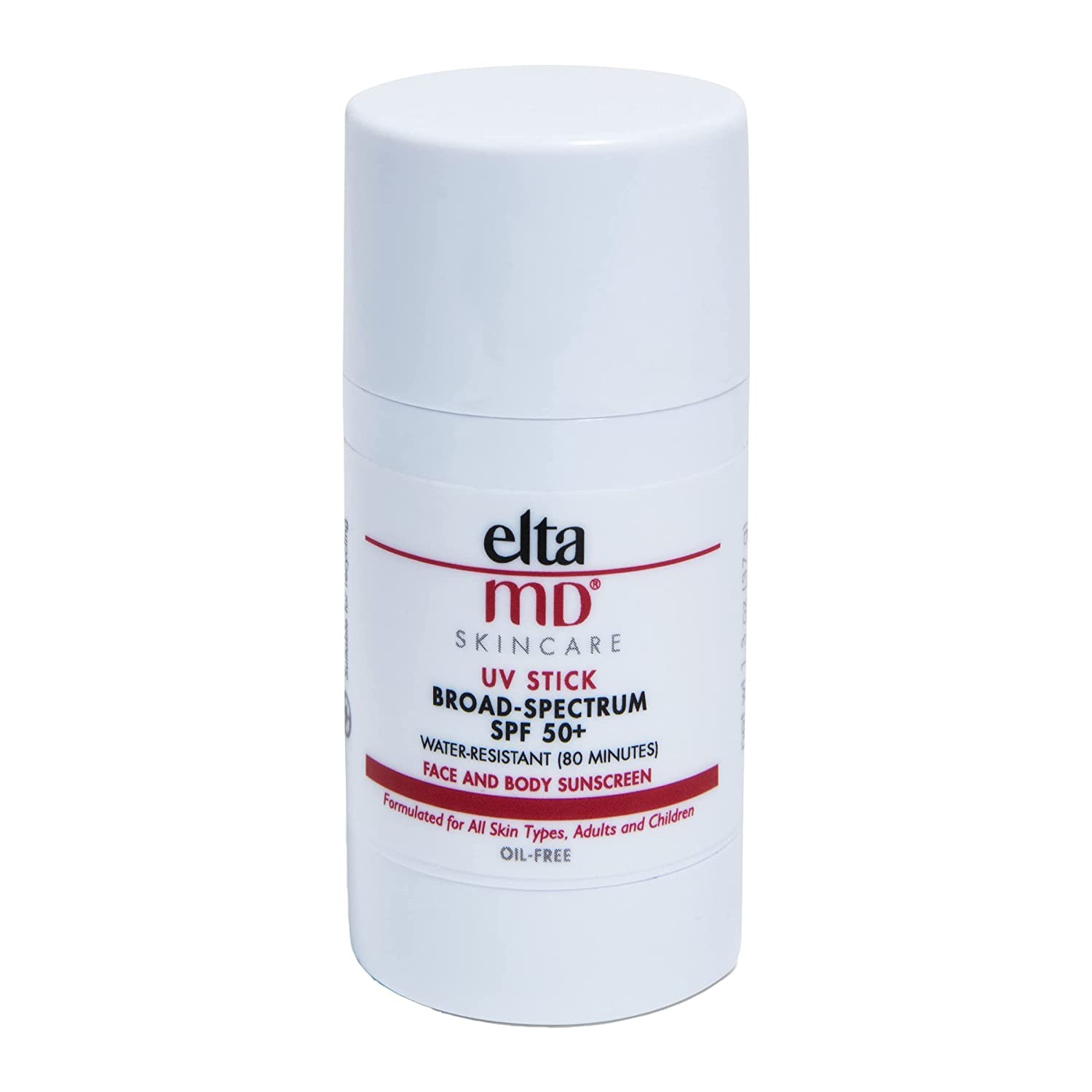 EltaMD UV Stick Face and Body Sunscreen SPF 50+. Best sunscreen stick for travel
EltaMD UV Stick Face and Body Sunscreen SPF 50+. Best sunscreen stick for travel
EltaMD UV Stick Face and Body Sunscreen, SPF 50+ – $35.00
This mineral sunscreen stick is designed for both face and body and provides broad-spectrum protection with SPF 50+. Its solid form makes it ideal for travel, and its gentle formula is suitable for all skin types.
3.2. Moisturizer Sticks with SPF
These dual-purpose products combine hydration with sun protection in a solid stick format. They’re perfect for travelers who want to streamline their skincare routine without compromising on sun safety.
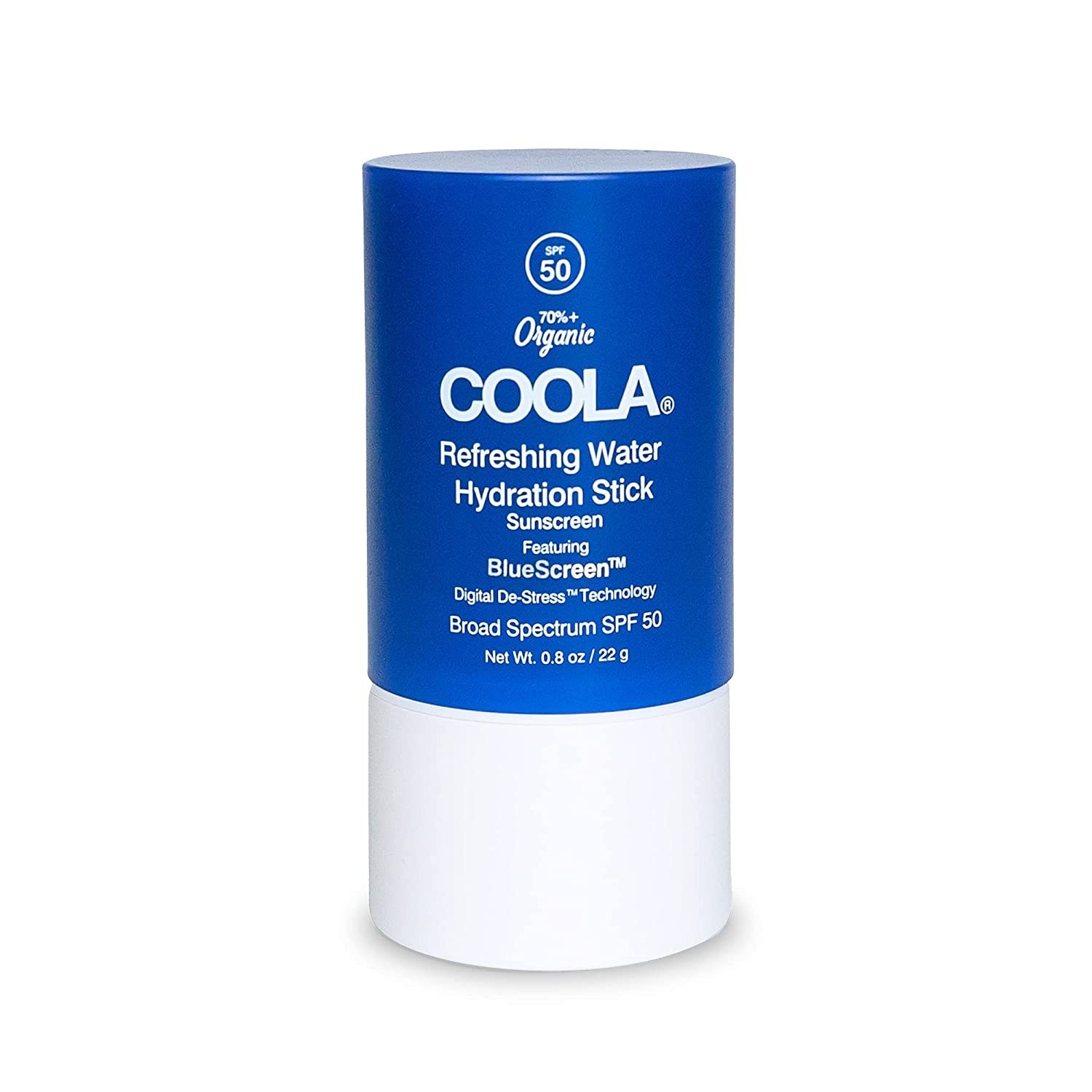 Coola Organic Refreshing Water Stick Face Moisturizer with SPF 50. Best moisturizer stick with SPF for travel
Coola Organic Refreshing Water Stick Face Moisturizer with SPF 50. Best moisturizer stick with SPF for travel
Coola Organic Refreshing Water Stick Face Moisturizer with SPF 50 – $30.00
This chemical sunscreen stick provides SPF 50 protection with a clear, hydrating finish. Infused with hyaluronic acid and coconut water, it feels cool and refreshing on the skin, offering both hydration and sun protection in one convenient stick. It also contains a proprietary blend of antioxidants and plant-derived actives that help protect your skin from blue light.
3.3. Travel-Sized Sunscreen Lotions
Many brands offer their popular sunscreen lotions in TSA-approved travel sizes (3.4 fl oz or 100ml). These smaller bottles ensure you have enough sunscreen for your trip without needing to decant.
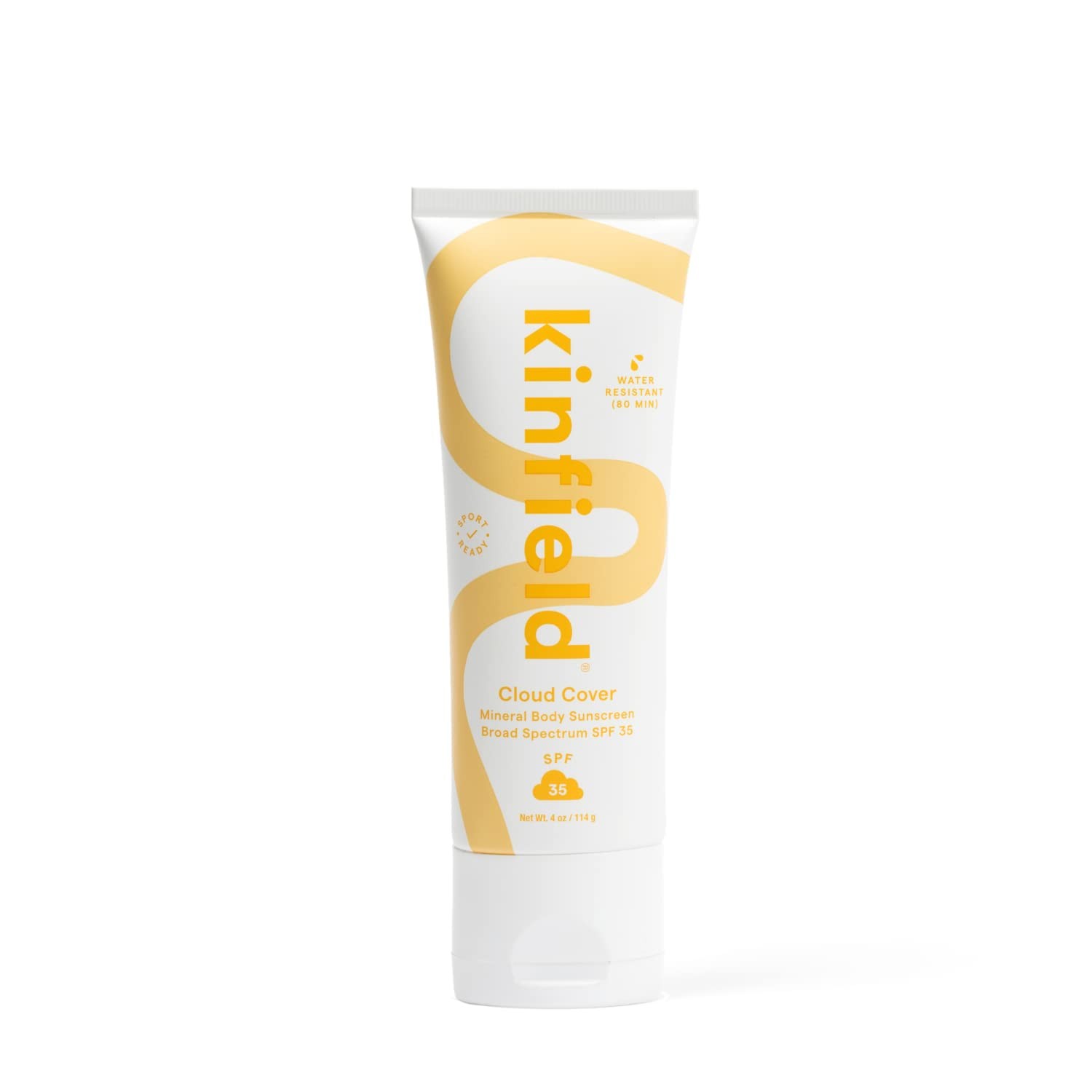 Kinfield Cloud Cover Mineral Body Sunscreen with Broad-Spectrum SPF 35. Best travel-sized sunscreen lotion
Kinfield Cloud Cover Mineral Body Sunscreen with Broad-Spectrum SPF 35. Best travel-sized sunscreen lotion
Kinfield Cloud Cover Mineral Body Sunscreen with Broad-Spectrum SPF 35 – $36.00
This mineral sunscreen lotion comes in a TSA-approved size and offers water-resistant, reef-safe protection with SPF 35. The formula includes hydrating glycerin and soothing aloe to keep your skin comfortable while shielding it from the sun.
3.4. High-SPF Sunscreen Lotions
If you prefer a higher SPF, look for travel-sized lotions that offer broad-spectrum protection without the need for decanting. These sunscreens are formulated to provide maximum protection in a convenient travel size.
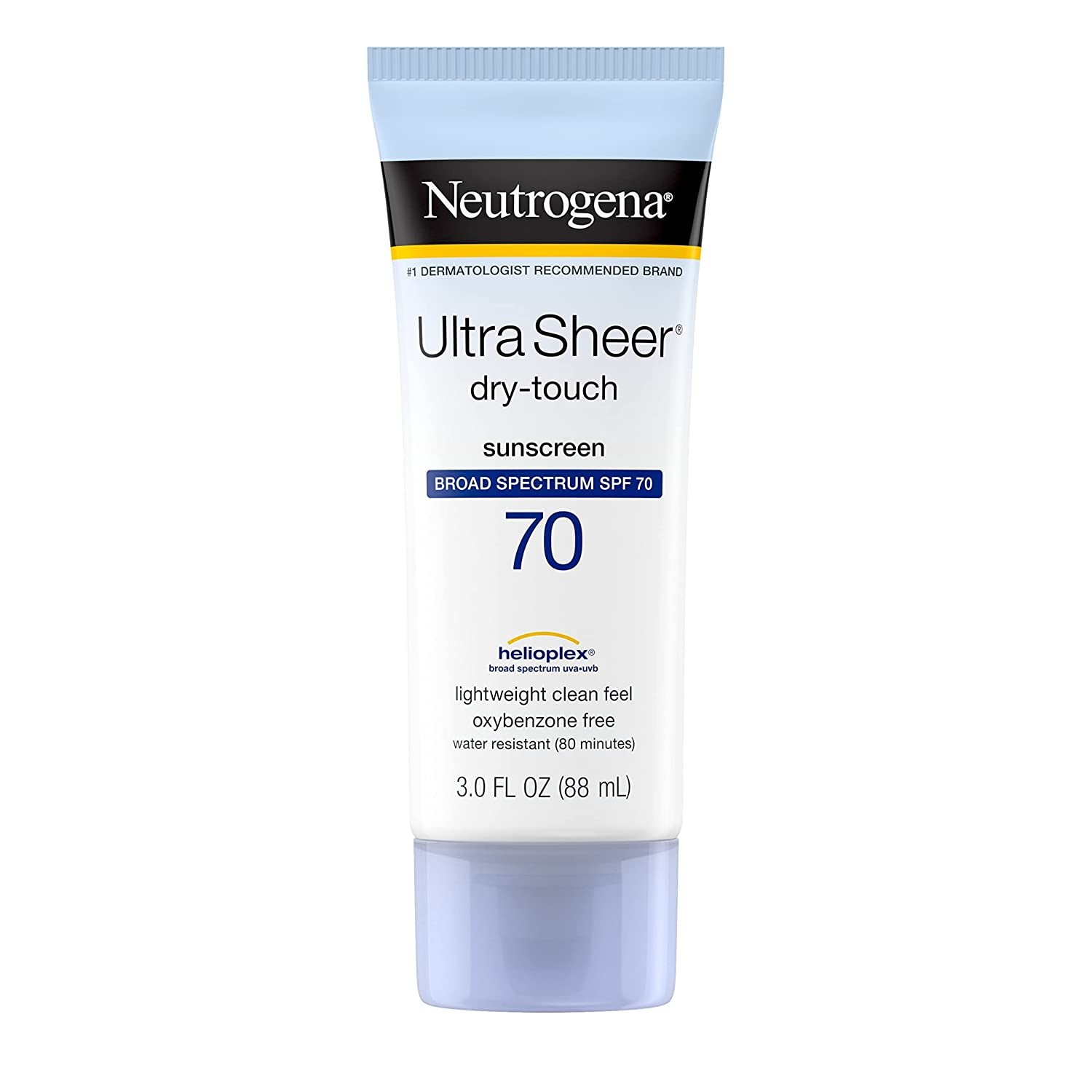 Neutrogena Ultra Sheer Dry-Touch Water Resistant and Non-Greasy Sunscreen Lotion with Broad Spectrum SPF 70. Best high-SPF sunscreen lotion for travel
Neutrogena Ultra Sheer Dry-Touch Water Resistant and Non-Greasy Sunscreen Lotion with Broad Spectrum SPF 70. Best high-SPF sunscreen lotion for travel
Neutrogena Ultra Sheer Dry-Touch Water Resistant and Non-Greasy Sunscreen Lotion with Broad Spectrum SPF 70 – $10.00
This chemical sunscreen provides SPF 70 protection in a lightweight, non-greasy formula. Its sheer texture ensures no white cast, making it a popular choice for those seeking high protection without compromising on aesthetics.
3.5. Mineral Sunscreen Sprays
Sunscreen sprays are easy to apply and reapply, making them ideal for active travelers or families with children. Look for mineral-based formulas that are gentle on the skin and environmentally friendly.
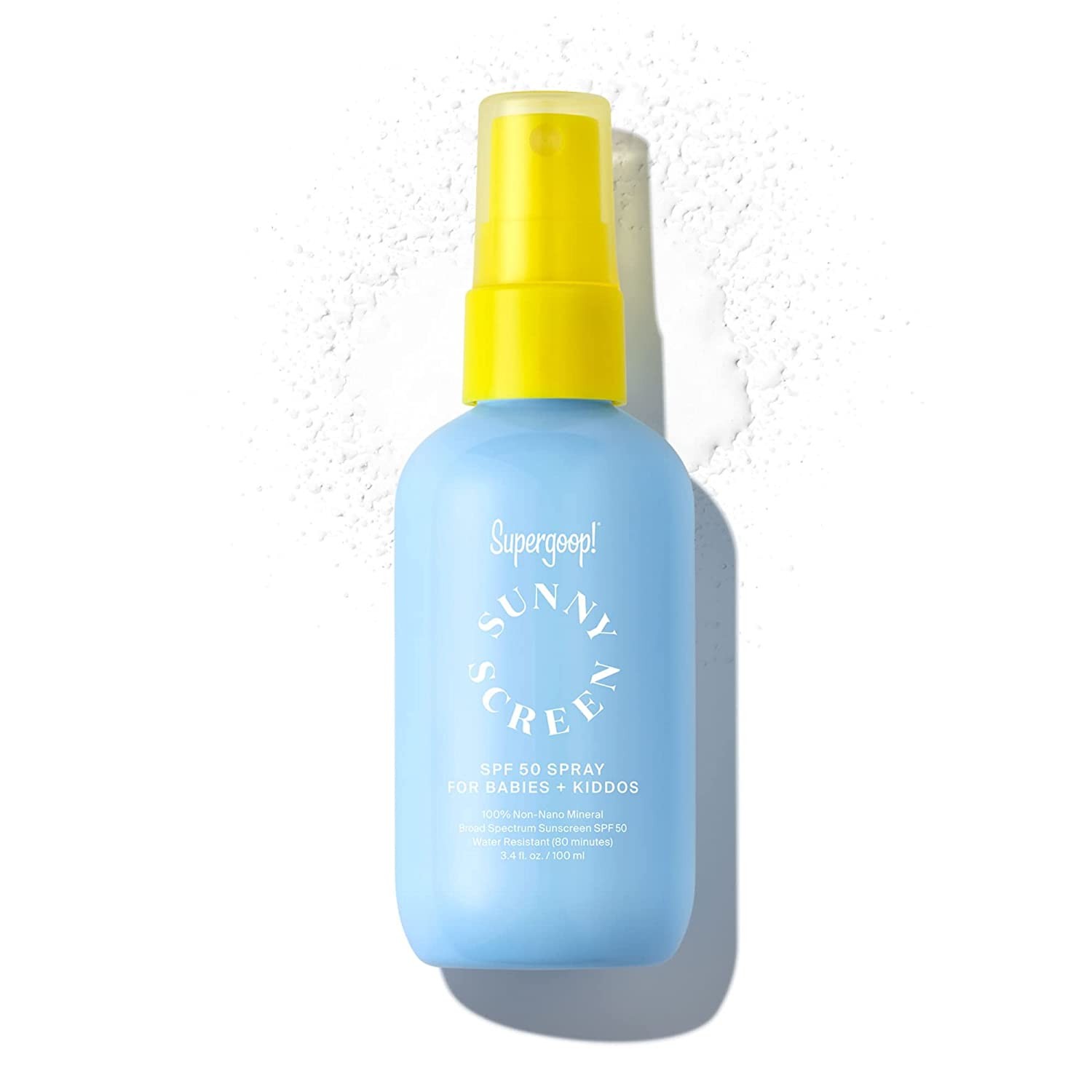 Supergoop! Sunnyscreen 100% Mineral Spray SPF 50 Spray for Babies + Kiddos. Best mineral sunscreen spray for travel
Supergoop! Sunnyscreen 100% Mineral Spray SPF 50 Spray for Babies + Kiddos. Best mineral sunscreen spray for travel
Supergoop! Sunnyscreen 100% Mineral Spray SPF 50 Spray for Babies + Kiddos – $30.00
This mineral sunscreen spray is designed for babies and children, making it a safe and effective option for the whole family. Free of potentially irritating ingredients like silicones, parabens, and fragrance, it offers broad-spectrum SPF 50 protection in an easy-to-use spray format.
4. The Importance of Sunscreen for Travelers
Sunscreen is an essential travel item for several reasons, protecting your skin from the harmful effects of UV radiation and helping prevent long-term damage.
4.1. Preventing Sunburns and Skin Damage
Exposure to UV radiation can cause sunburn, premature aging, and an increased risk of skin cancer. Sunscreen acts as a barrier, absorbing or reflecting UV rays and reducing the risk of these harmful effects.
4.2. Reducing the Risk of Skin Cancer
Regular sunscreen use is one of the most effective ways to reduce your risk of developing skin cancer. By protecting your skin from UV damage, sunscreen helps prevent the cellular changes that can lead to cancerous growths.
4.3. Maintaining Skin Health and Appearance
Sunscreen helps maintain the health and appearance of your skin by preventing sunspots, wrinkles, and other signs of premature aging. Incorporating sunscreen into your daily routine can keep your skin looking youthful and radiant.
5. How to Choose the Right Sunscreen
Choosing the right sunscreen involves considering several factors, including SPF level, skin type, and activity level.
5.1. Understanding SPF Levels
SPF (Sun Protection Factor) measures how well a sunscreen protects against UVB rays, the primary cause of sunburn. The higher the SPF, the more protection it offers.
- SPF 15: Blocks about 93% of UVB rays.
- SPF 30: Blocks about 97% of UVB rays.
- SPF 50: Blocks about 98% of UVB rays.
- SPF 70: Blocks about 98.5% of UVB rays.
While higher SPF levels offer slightly more protection, no sunscreen can block 100% of UVB rays.
5.2. Choosing Between Mineral and Chemical Sunscreens
Sunscreen formulations fall into two main categories: mineral and chemical.
- Mineral Sunscreens: Use mineral ingredients like zinc oxide and titanium dioxide to create a physical barrier that reflects UV rays. They are generally considered safer for sensitive skin and the environment.
- Chemical Sunscreens: Use chemical filters to absorb UV rays and release heat. They tend to be more lightweight and easier to apply without leaving a white cast.
5.3. Considering Your Skin Type
Different skin types require different sunscreen formulations.
- Sensitive Skin: Look for mineral sunscreens that are fragrance-free and hypoallergenic.
- Oily Skin: Choose oil-free or non-comedogenic sunscreens to prevent clogged pores.
- Dry Skin: Opt for hydrating sunscreens with moisturizing ingredients like hyaluronic acid or glycerin.
- Combination Skin: Select a balanced formula that provides adequate protection without being too heavy or greasy.
5.4. Considering Your Activity Level
If you plan to be active outdoors, choose a water-resistant or sweat-resistant sunscreen. These formulas are designed to stay on the skin even when you’re sweating or swimming. Reapply sunscreen every two hours, or more frequently if you’re swimming or sweating heavily.
6. Sunscreen Application Tips
Proper sunscreen application is crucial for ensuring adequate protection.
6.1. Applying Sunscreen Correctly
Apply sunscreen liberally to all exposed skin, including your face, neck, ears, and hands. Don’t forget areas like the tops of your feet and the back of your neck. Use about one ounce (a shot glass full) to cover your entire body.
6.2. Timing Your Application
Apply sunscreen 15-30 minutes before sun exposure to allow it to absorb into the skin. This helps ensure that the sunscreen is fully effective when you need it most.
6.3. Reapplying Sunscreen
Reapply sunscreen every two hours, or immediately after swimming, sweating, or towel drying. Even water-resistant sunscreens lose effectiveness over time and need to be reapplied to maintain protection.
6.4. Don’t Forget Lip Protection
Your lips are also susceptible to sun damage. Use a lip balm with SPF 30 or higher to protect them from sunburn and prevent chapping.
7. Understanding TSA Guidelines for Sunscreen
Navigating TSA guidelines can be confusing, but understanding the rules for sunscreen can help you avoid hassles at the airport.
7.1. The 3-1-1 Rule
The TSA’s 3-1-1 rule applies to liquids, gels, and aerosols in carry-on bags. Each item must be in a travel-sized container that is 3.4 ounces (100 milliliters) or less. All items must fit in a single, quart-sized, clear plastic zip-top bag.
7.2. Exceptions for Medically Necessary Items
Sunscreen is not typically considered a medically necessary item, so the 3-1-1 rule applies. However, if you have a medical condition that requires specific sunscreen, you may be able to bring a larger quantity. You will need to declare the item to a TSA officer and may be subject to additional screening.
7.3. Sunscreen in Checked Baggage
You can pack full-sized sunscreen bottles in your checked baggage without restrictions. This is a convenient option if you prefer to bring your regular sunscreen and don’t want to worry about the 3-1-1 rule.
8. The Impact of Sunscreen on the Environment
Certain sunscreen ingredients can harm marine ecosystems, particularly coral reefs. Choosing reef-safe sunscreen can help minimize your environmental impact.
8.1. Reef-Safe Sunscreen Ingredients
Reef-safe sunscreens are formulated without oxybenzone and octinoxate, two chemicals known to damage coral reefs. Look for sunscreens that use mineral-based active ingredients like zinc oxide and titanium dioxide.
8.2. The Importance of Eco-Friendly Choices
By choosing reef-safe sunscreen, you can help protect coral reefs and other marine life. Many destinations with sensitive marine environments have banned sunscreens containing oxybenzone and octinoxate, so opting for eco-friendly formulas is a responsible choice for travelers.
8.3. Brands That Offer Reef-Safe Options
Several brands offer reef-safe sunscreen options, including:
- Thinksport: Known for its mineral-based, reef-safe formulas.
- Badger Balm: Offers organic and reef-safe sunscreens with simple, natural ingredients.
- Stream2Sea: Specializes in reef-safe sunscreens that are biodegradable and non-toxic to aquatic life.
9. The Science Behind Sunscreen Ingredients
Understanding the science behind sunscreen ingredients can help you make informed choices about the products you use.
9.1. Active Ingredients and How They Work
Active ingredients in sunscreen work by either absorbing or reflecting UV radiation.
- Mineral Ingredients (Zinc Oxide and Titanium Dioxide): Create a physical barrier that reflects UV rays away from the skin.
- Chemical Ingredients (Oxybenzone, Octinoxate, Avobenzone): Absorb UV rays and convert them into heat, which is then released from the skin.
9.2. Inactive Ingredients and Their Role
Inactive ingredients in sunscreen play a role in the product’s texture, stability, and application. These ingredients can include:
- Emollients: Help to soften and moisturize the skin.
- Thickeners: Provide the desired consistency and texture.
- Preservatives: Prevent the growth of bacteria and fungi.
- Fragrances: Add a pleasant scent to the product.
9.3. Potential Allergens and Irritants
Some sunscreen ingredients can cause allergic reactions or skin irritation in sensitive individuals. Common allergens include fragrances, preservatives, and certain chemical filters. If you have sensitive skin, look for fragrance-free, hypoallergenic sunscreens with mineral-based active ingredients.
10. Planning Your Sun Protection Strategy
Creating a sun protection strategy involves more than just choosing the right sunscreen. It includes understanding your risk factors, planning for sun exposure, and incorporating other protective measures.
10.1. Assessing Your Risk Factors
Factors that can increase your risk of sun damage include:
- Skin Type: Fair skin is more susceptible to sunburn and skin damage.
- Family History: A family history of skin cancer increases your risk.
- Geographic Location: Living in areas with high UV radiation levels, such as high altitudes or near the equator, increases your risk.
- Medications: Some medications can make your skin more sensitive to the sun.
10.2. Planning for Sun Exposure
When planning outdoor activities, consider the time of day and the intensity of the sun. UV radiation is strongest between 10 a.m. and 4 p.m. Limit your exposure during these hours and seek shade whenever possible.
10.3. Combining Sunscreen with Other Protective Measures
Sunscreen should be part of a comprehensive sun protection strategy that includes:
- Wearing Protective Clothing: Cover up with long sleeves, pants, and a wide-brimmed hat.
- Seeking Shade: Stay in the shade, especially during peak sun hours.
- Wearing Sunglasses: Protect your eyes from UV damage with sunglasses that block 100% of UVA and UVB rays.
11. Common Sunscreen Myths Debunked
There are many misconceptions about sunscreen. Understanding the facts can help you protect your skin effectively.
11.1. Myth: You Only Need Sunscreen on Sunny Days
Fact: UV radiation can penetrate clouds, so you can still get sunburned on cloudy days. Apply sunscreen every day, regardless of the weather.
11.2. Myth: Darker Skin Tones Don’t Need Sunscreen
Fact: While darker skin tones have more melanin, which provides some natural protection, everyone is susceptible to sun damage and skin cancer. Sunscreen is essential for all skin tones.
11.3. Myth: A Higher SPF Means You Can Stay in the Sun Longer
Fact: SPF measures the level of protection, not the duration. Reapply sunscreen every two hours, regardless of the SPF level.
11.4. Myth: Sunscreen Is Only Necessary at the Beach
Fact: You can be exposed to UV radiation anywhere outdoors, including while gardening, walking, or driving. Apply sunscreen whenever you’re outside.
12. Traveling to Napa Valley? Let TRAVELS.EDU.VN Handle the Details
Planning a trip to Napa Valley involves more than just packing sunscreen. From wine tours to gourmet dining, let TRAVELS.EDU.VN handle all the details for a seamless and unforgettable experience.
12.1. Why Choose TRAVELS.EDU.VN for Your Napa Valley Trip?
At TRAVELS.EDU.VN, we specialize in creating customized travel experiences tailored to your preferences. Here’s what sets us apart:
- Expert Knowledge: Our team has extensive knowledge of Napa Valley, including the best wineries, restaurants, and hidden gems.
- Personalized Service: We work with you to create a bespoke itinerary that matches your interests and budget.
- Exclusive Access: We have established relationships with local vendors, allowing us to offer exclusive experiences and perks.
- Stress-Free Planning: We handle all the logistics, from booking accommodations to arranging transportation, so you can relax and enjoy your trip.
12.2. Napa Valley Tour Packages Offered by TRAVELS.EDU.VN
We offer a variety of Napa Valley tour packages to suit every traveler:
- Wine Lover’s Escape: A curated tour of Napa Valley’s top wineries, including private tastings and vineyard tours.
- Gourmet Getaway: Indulge in Napa Valley’s culinary scene with gourmet meals, cooking classes, and wine pairings.
- Relaxation Retreat: Unwind with spa treatments, yoga sessions, and scenic hikes amidst Napa Valley’s picturesque landscapes.
- Customized Itineraries: Create your own unique Napa Valley experience with our personalized planning service.
12.3. How TRAVELS.EDU.VN Addresses Traveler Challenges
We understand the challenges travelers face when planning a trip to Napa Valley:
- Difficulty Finding Suitable Packages: We offer a diverse range of packages to suit various interests and budgets.
- Time-Consuming Planning: We handle all the details, saving you time and effort.
- Concerns About Service Quality: We partner with reputable local vendors to ensure exceptional service and reliability.
- Desire for Unique Experiences: We offer exclusive experiences and hidden gems that you won’t find on standard tours.
- Need for Updated Information: We provide up-to-date information on destinations, pricing, and travel tips.
12.4. Napa Valley Travel Tips from TRAVELS.EDU.VN
- Best Time to Visit: The best time to visit Napa Valley is during the spring (March-May) or fall (September-November) when the weather is mild and the vineyards are lush.
- Transportation: Consider hiring a private driver or joining a guided tour to avoid the hassle of driving between wineries.
- Accommodation: Napa Valley offers a range of accommodation options, from luxury resorts to cozy bed and breakfasts.
- Dining: Make reservations in advance, especially for popular restaurants and tasting menus.
Table: Napa Valley Accommodation Options
| Hotel | Average Price per Night | Description | Amenities |
|---|---|---|---|
| The Meritage Resort & Spa | $400 – $600 | Luxury resort with vineyards, spa, and multiple dining options. | Spa, pools, wine cave, multiple restaurants. |
| Auberge du Soleil | $800 – $1200 | Luxurious retreat with stunning views, Michelin-starred dining, and a serene atmosphere. | Spa, infinity pool, fine dining. |
| Carneros Resort and Spa | $600 – $900 | Farmhouse-style resort with private cottages, farm-to-table dining, and a spa. | Spa, pools, multiple restaurants, bocce courts. |
| Hotel Yountville | $500 – $800 | Upscale hotel in the heart of Yountville with easy access to restaurants and shops. | Spa, outdoor pool, fine dining. |
| Meadowood Napa Valley | $900 – $1500 | Exclusive resort with a championship golf course, spa, and exceptional service. | Golf course, spa, pools, multiple restaurants. |
Table: Napa Valley Wine Tour Pricing
| Tour Type | Average Price per Person | Description | Inclusions |
|---|---|---|---|
| Group Wine Tour | $150 – $250 | Guided tour of multiple wineries with tastings and transportation included. | Transportation, tasting fees, guided tour. |
| Private Wine Tour | $500 – $1000 | Exclusive tour of wineries with a private driver and customized itinerary. | Private transportation, customized itinerary, tasting fees (may vary). |
| Hot Air Balloon Wine Tour | $300 – $500 | Scenic hot air balloon ride over Napa Valley followed by a wine tasting. | Hot air balloon ride, champagne toast, wine tasting. |
| Biking Wine Tour | $100 – $200 | Guided bike tour of vineyards with stops for wine tastings. | Bike rental, helmet, guided tour, tasting fees. |
| Culinary Wine Tour | $300 – $600 | Tour that combines wine tastings with gourmet food experiences, such as cooking classes or multi-course meals. | Wine tastings, gourmet meals, cooking classes. |
Contact TRAVELS.EDU.VN Today
Ready to plan your dream trip to Napa Valley? Contact TRAVELS.EDU.VN today for a personalized consultation. Our team of experts is here to help you create an unforgettable experience.
- Address: 123 Main St, Napa, CA 94559, United States
- WhatsApp: +1 (707) 257-5400
- Website: TRAVELS.EDU.VN
Frequently Asked Questions (FAQs)
1. Is it safe to put sunscreen in a travel bottle?
It is generally not recommended to put sunscreen in a travel bottle, as it can degrade the sunscreen’s effectiveness due to reactions with the container, reduced protection against sunlight and air, and the risk of contamination.
2. How long does sunscreen last in a travel bottle?
Even if properly stored, sunscreen can degrade quickly, sometimes within days of being transferred to a travel bottle. It’s best to use travel-sized sunscreens or stick formulas to avoid degradation.
3. What are the best travel-friendly sunscreen options?
The best travel-friendly sunscreen options include sunscreen sticks, moisturizer sticks with SPF, travel-sized sunscreen lotions, high-SPF sunscreen lotions, and mineral sunscreen sprays.
4. How can I ensure my sunscreen is effective while traveling?
To ensure your sunscreen is effective, use travel-sized sunscreens, store sunscreen in its original packaging, apply sunscreen liberally and reapply every two hours, and combine sunscreen with other protective measures like wearing protective clothing and seeking shade.
5. What SPF level should I use while traveling?
Aim for an SPF of 30 or higher for adequate protection. Choose a broad-spectrum sunscreen that protects against both UVA and UVB rays.
6. Are mineral sunscreens better for travel?
Mineral sunscreens are a good option for travel, especially for sensitive skin. They are also considered reef-safe and environmentally friendly.
7. How do I properly store sunscreen while traveling?
Store sunscreen in a cool, dry place away from direct sunlight. Avoid leaving sunscreen in hot cars or exposed to high temperatures.
8. Can I bring full-sized sunscreen bottles in my checked baggage?
Yes, you can pack full-sized sunscreen bottles in your checked baggage without restrictions.
9. What are the risks of using expired sunscreen?
Expired sunscreen may not provide adequate protection, as the active ingredients can degrade over time. Always check the expiration date before using sunscreen.
10. How can TRAVELS.EDU.VN help me plan my trip to Napa Valley?
TRAVELS.EDU.VN offers customized Napa Valley travel experiences tailored to your preferences, including wine tours, gourmet dining, and relaxation retreats. We handle all the logistics, ensuring a seamless and unforgettable trip.
Don’t risk compromising your sun protection by decanting sunscreen. Choose travel-friendly options and let travels.edu.vn handle the details of your next Napa Valley adventure for a worry-free, sun-safe vacation. Contact us today to start planning your perfect getaway!
